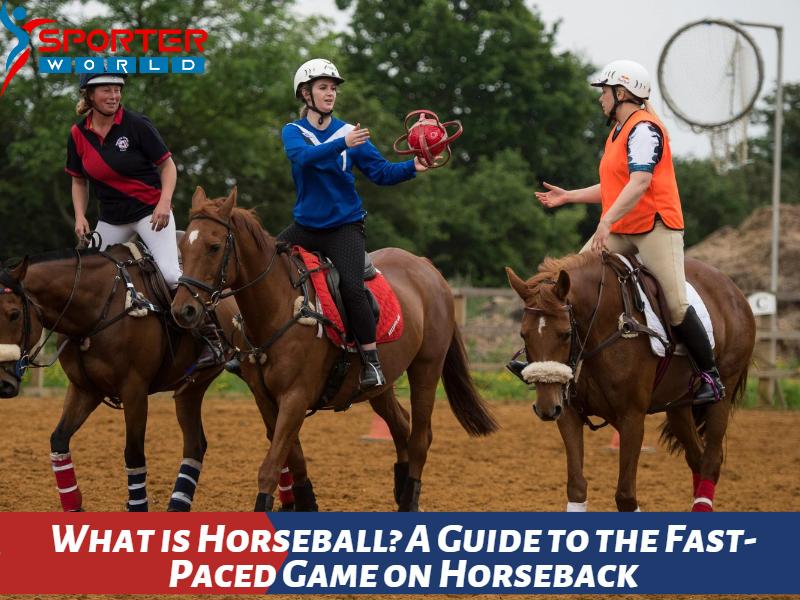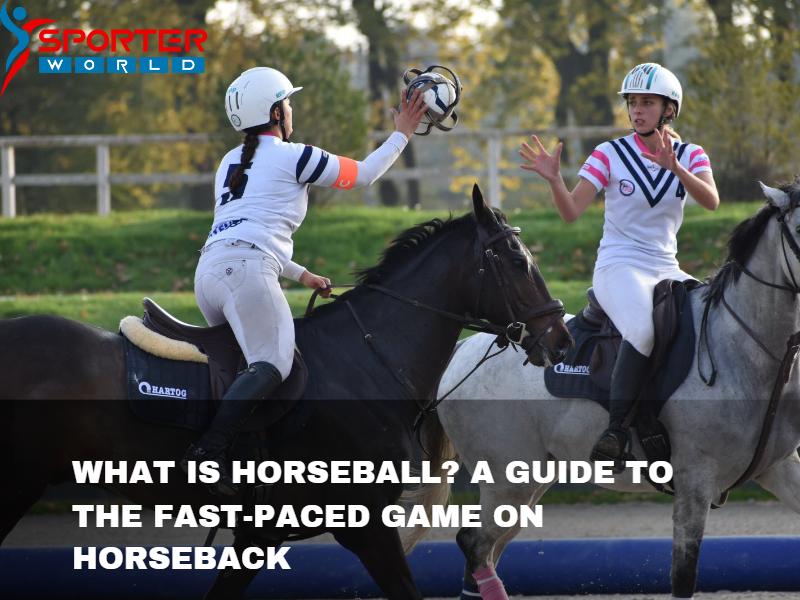Have you ever heard of horseball? It’s a sport that combines elements of basketball, polo, and rugby, all while riding on horseback. But don’t worry if you’re not a skilled equestrian – you don’t need to be an expert to try your hand at horseball.
Originating in France, horseball has gained popularity around the world, including in the United States. It’s a fast-paced game that challenges riders’ horsemanship skills and teamwork abilities. Plus, it’s a great way to bond with your horse and meet other equestrians. In this article, we’ll delve into the rules of horseball, explain how it’s played, and discuss why it’s become a beloved sport for horse lovers everywhere.
What is Horseball?
Horseball is an equestrian team sport that combines elements of basketball, rugby, and horseback riding. It is played on horseback and involves two teams competing to score goals by throwing a ball into a high net. Here are some key aspects of Horseball:
- Objective: Horseball aims to score goals by carrying the ball and throwing it into the opposing team’s net. The team with the highest number of goals at the end of the game wins.
- Equipment: The game is played with a large, inflatable ball with handles called the horseball. The ball is typically made of leather or synthetic materials. Each player has a helmet, protective gear, and riding equipment.
- Teams: Two teams, each consisting of four or six players, compete against each other. The players maneuver on horseback, passing the ball and working together to score goals.
- Gameplay: The game begins with a “throw-in,” where the ball is placed at the center of the field, and players from both teams try to gain possession. They pass the ball among themselves while riding their horses, using teamwork and strategic positioning to create scoring opportunities.
- Scoring: To score a goal, a player must carry the ball while on horseback and throw it into the opposing team’s net. The net is positioned high above the ground to make scoring challenging. Each successful goal counts as one point.
- Rules: Horseball has specific rules and regulations governing player conduct, ball handling, fouls, and penalties. These rules ensure fair play, safety, and sportsmanship during the game.
- Skill and Strategy: Horseball requires a combination of riding skills, ball-handling abilities, teamwork, and strategic thinking. Players must have good horsemanship, agility, and the ability to control their horses while also coordinating with their teammates.
Horseball is a fast-paced and exciting sport that showcases the partnership between horse and rider. It requires athleticism, coordination, and a deep understanding of the game. It is played worldwide and has organized competitions at both national and international levels.
Do Horses Use Ball Toys?
Playing is an essential part of a horse’s life, and they often get bored if there isn’t enough enrichment in their day. Toys such as ball toys can be just the thing to keep them entertained. Ball toys come in all shapes and sizes with rolling, hanging, bouncing, and treat dispensing options – giving your horse many choices for how to play.
Whether your horse loves to roll and toss around big balls or loves to nuzzle and cuddle small balls along the ground, Chewy has just what you need, with plenty of ball toy styles available. These horsing-around toys will also help encourage healthy exercise while allowing your horse time for mental stimulation. So don’t forget about fun – grab yourself some ball toys today.
How Do You Teach A Horse To Play With Ball Toys?
Teaching a horse to play with ball toys can be a fun and enriching activity. Here are some steps to help you introduce and train your horse to play with ball toys:
- Introduction and Familiarization: Start by introducing the ball toy to your horse in a controlled and safe environment. Allow your horse to approach and investigate the ball at their own pace. Use positive reinforcement, such as praise or treats, to create a positive association with the toy.
- Desensitization: Some horses may initially be cautious or apprehensive about the ball. Gradually desensitize your horse to the ball by introducing it in different sizes, colors, and textures. Encourage your horse to touch and interact with the ball using its nose or hoof.
- Target Training: Teach your horse to touch or target the ball with its nose or hoof. Use a target stick or your hand to guide your horse’s nose or hoof toward the ball. When your horse makes contact with the ball, reward them with praise or treats. Repeat this process to reinforce the behavior.
- Rolling and Pushing: Once your horse is comfortable targeting the ball, encourage them to roll or push it with their nose or hoof. Start with gentle movements and gradually increase the intensity. Reward your horse for any interaction with the ball, even if it’s a small nudge or roll.
- Play and Interaction: Engage in interactive play sessions using the ball toy with your horse. Roll the ball toward your horse and encourage them to interact with it. Allow your horse to explore different ways of playing, such as pushing, rolling, or chasing the ball. Join in the play by using verbal cues or gentle encouragement.
- Gradual Progression: You can introduce more advanced games or challenges as your horse becomes more confident and comfortable with the ball. Set up obstacles or targets for your horse to navigate the ball through, or incorporate the ball into groundwork exercises to enhance coordination and focus.
- Safety Considerations: Always ensure the ball toy is safe for your horse, with no small parts that can be chewed or swallowed. Supervise your horse during play sessions to prevent any potential accidents or injuries. Consult a professional trainer if your horse shows signs of fear or aggression toward the ball.
Remember, each horse learns at their own pace, so be patient and positive throughout the training process. Make the experience enjoyable for your horse and adapt the training methods to suit their temperament and learning style. Playing with ball toys can provide mental stimulation and physical exercise for your horse, contributing to their overall well-being and enrichment.
Read More: When Is District 8 Hockey?- Detailed Schedule

What is The Term Horseball?
Horseball is an equestrian team sport that combines elements of basketball, rugby, and horseback riding. It is played on horseback, and the objective is to score goals by throwing a ball into the opposing team’s net. The game involves teamwork, strategic positioning, and rider-and-horse coordination. Horseball is played worldwide and has organized competitions at both national and international levels. It is a fast-paced and exciting sport showcasing the horse and rider partnership.
Tips For First-Time Horseball Players:
If you’re a first-time horseball player, here are some tips to help you get started:
- Familiarize Yourself with the Rules: Take the time to learn and understand the rules of horseball. Familiarize yourself with the scoring system, player positions, and basic gameplay. This will help you grasp the fundamentals and play the game effectively.
- Focus on Horsemanship Skills: Strong horsemanship skills are essential in horseball. Practice your riding techniques like balance, control, and responsiveness to your horse’s movements. Develop a good seat and learn to communicate effectively with your horse through cues and aids.
- Work on Ball Handling: Practice handling the horseball both on the ground and while mounted. Get comfortable holding and passing the ball, and work on your accuracy and control. Practice passing and catching the ball with teammates to improve your coordination and teamwork.
- Understand Positioning and Strategy: Study the different positions in horseball and their roles and responsibilities. Learn about positioning on the field and how to create and exploit scoring opportunities. Develop a sense of teamwork and understand how to support your teammates and work together as a cohesive unit.
- Start with Basic Drills: Begin with simple drills to improve your skills and build confidence. Work on exercises focusing on ball control, passing, shooting, and maneuvering your horse. Gradually progress to more complex drills and game scenarios as you become more comfortable with the basics.
- Communicate with Your Teammates: Communication is key in horseball. Develop clear and concise communication with your teammates to coordinate movements, passes, and strategies. Use verbal cues, hand signals, or pre-determined signals to communicate effectively during the game.
- Emphasize Safety: Prioritize safety at all times. Wear proper protective gear, including a helmet, boots, and appropriate clothing. Ensure that your horse is properly equipped with suitable tack and equipment. Maintain control of your horse and be mindful of your surroundings to avoid collisions or accidents.
- Seek Professional Guidance: Consider working with a qualified horseball trainer or coach who can provide guidance, instruction, and feedback tailored to your skill level. They can help you refine your techniques, develop game strategies, and improve your overall performance.
Remember to have fun and enjoy the experience of playing horseball. It’s a dynamic and exciting sport that allows you to showcase your horsemanship skills and teamwork. You’ll become more proficient and confident as a horseball player with practice and dedication.
Read More: High Power Rifle Shooting: The Basics and Beyond

Frequently Asked Questions
Is horseball a dangerous sport?
Like any equestrian sport, there are inherent risks involved in horseball. However, the risks can be minimized with proper training, equipment, and adherence to safety guidelines. It is important to wear appropriate safety gear, such as helmets and protective vests, and to practice good horsemanship skills to ensure a safe and enjoyable experience.
Can any horse participate in horseball?
While any horse can potentially participate in horseball, certain traits and training make some horses more suitable than others. A horse should be well-trained, responsive, agile, and comfortable with fast-paced movements and ball-like objects. Working with a knowledgeable trainer can help determine your horse’s suitability for the sport.
Do I need prior riding experience to play horseball?
Prior riding experience is beneficial for playing horseball, as it helps with balance, control, and communication with the horse. However, beginners can still participate and learn the sport. Taking riding lessons and gradually developing your riding skills is recommended before fully engaging in horseball.
Are there age restrictions for horseball players?
The age restrictions for horseball players can vary depending on the specific rules and regulations of the governing body or organization. In general, horseball can be enjoyed by participants of various age groups, including children, teenagers, and adults. It’s advisable to check with local horseball associations or clubs to determine any specific age requirements.
Can I play horseball without owning a horse?
If you don’t own a horse, participating in horseball may still be possible by joining a team or club that provides horses for their players. Some equestrian facilities offer horse rental services or lease programs for horseball activities. Contact local horseball organizations or trainers to inquire about such opportunities.
Conclusion
Horseball is an exciting and dynamic equestrian sport that riders of all levels can enjoy. To ensure a safe and enjoyable experience, it’s important to prioritize safety, take lessons with a qualified trainer, seek professional guidance when necessary, and follow the rules and regulations of the governing body or organization.



